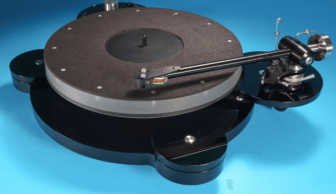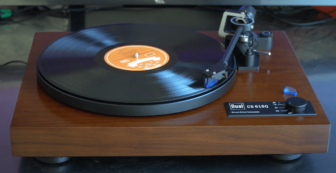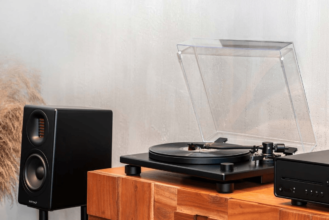PRO-JECT RPM 9 CARBON DC Review
Pro-Ject’s RPM 9 Carbon turntable with balanced output gets close attention from Noel Keywood. Read our PRO-JECT RPM 9 CARBON DC Review.
Superficially about Pro-Ject’s high-end RPM 9 Carbon DC turntable, this review is also about the whole idea of junking the conventional way of connecting a turntable for a better one that eliminates noise, hum and other rubbish. Additionally, importers Henley Audio fitted Ortofon’s latest top moving magnet cartridge, the 2M Black LVB250. So here’s a top turntable and a new Ortofon cartridge, all connected up in pristine fashion through balanced cables.
I have been running an SME 3 1 2S arm with balanced cables for a long time and this is the only way to go. But to avoid techno-twaddle in this review I’ll concentrate on the turntable – the practicalities and benefits of going balanced exiled to a box-out.
Main difficulty: to connect up a turntable using balanced cables you must have a phono preamplifier with balanced inputs – these are rare. Pro-Ject recently introduced the Phono Box RS2, reviewed in our March 2021 issue, and I inevitably used it in this review. The RS2 then is an integral part of what is being reviewed here.
The RPM 9 Carbon turntable is, I’ll warn, specialised. You get bags of bits and there’s a lot to set up, all in old-fashioned style, notably weight-on-thread to apply outward bias to the arm. Confusing to me was the presence of no fewer than four counterweights where most arms need one and our SMEs two. The platter weighs a heavy 4.5kg and needs careful handling when lowering onto the bearing, since there is a thrust ball at top. A sturdy but compact plinth also carries the arm. There is no motor on the plinth, so no mains power, no electrical connection and therefore no possibility to set up a hum loop. Just platter and arm.
The motor is a separate unit entirely, free standing and connected only by a slender rubber O-ring drive belt. To give it mass and stability the motor has its own heavy base with rubber feet, and can be switched to 33rpm or 45rpm by a
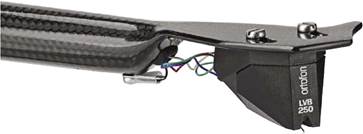
small button on its top face, LEDs confirming speed-lock. Being a d.c. servo motor it has an external power supply delivering d.c. through a slim cable. Its on-board electronic servo-system senses when correct speed has been reached, flashing LEDs turning steady.
There is a motor set-up
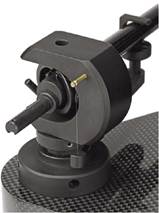
template to get positioning correct, giving a spindle-to-spindle distance of 214mm. Our Wow&Flutter meter with connected spectrum analyser showed the mechanism works best with the belt running slack, drawback being there’s slippage at start-up, making start-up slow. A flat, precision ground drive belt offers better performance than an O-ring and at the price the RPM9 would be better fitted with one I believe.
The arm is of wrapped carbon fibre construction, with integral carbon fibre head shell. Without removable head shell cartridge changing is difficult, as with all one-piece arms. Arm height can be adjusted to change cartridge vertical tracking angle (VTA) and the arm tube can be unclamped and rotated to change cartridge azimuth. A weight and thread apply bias (antiskating). Four counterweights cope with all cartridge weights.
The head shell has no parallel sides to facilitate cartridge alignment and unsurprisingly the Ortofon 2M Black LVB250 cartridge in our sample was badly misaligned, being set at front of the headshell to produce 1.8% tracking distortion;
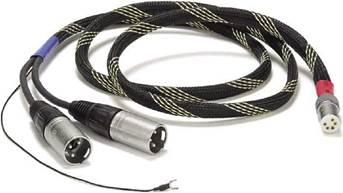
moving it to the back this fell to a low 0.6%. The flat finger lift has no clearance above LP surface to slide a finger underneath – and it slips out of finger grip in any case. I hand cue only so this arm was a no-no for me. Improvement in headshell geometry and an upward curved finger lift would both help; such finger lifts can be optional, as with SME. The arm was a loose fit into the rest clip, allowing it to be knocked out accidentally; a clip of some sort is common here; I used a tie-wrap for safety.
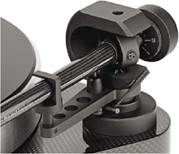
The arm has a socket at the base of its pillar that carries signal leads and earth. It lies deep in a recess and is difficult to see and reach, something best done with platter removed. Fitment of a socket allows leads to be changed: conventional unbalanced with RCA phono plugs, or balanced with XLR plugs; we were supplied both.
SOUND QUALITY
The Pro-Ject RPM 9 Carbon was
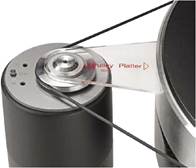
connected to their Phono Box RS2 phono stage using the balanced cable supplied. Since the Ortofon 2M Black LVB250 cartridge is a moving magnet (MM) type, the RS2 was set for balanced input and minimal capacitive loading. Output from RS2 was delivered by balanced Chord Company Epic cables to a Creek i20 amplifier’s balanced XLR input, that was in turn connected to our Martin Logan ESL-X hybrid electrostatic loudspeakers via Chord Company Signature Reference cables. This was an all-balanced system then, at least in its connection methodologies, the Creek being a conventional unbalanced amplifier internally.
Pro-Ject’s heavy platter, large main bearing and solid plinth worked together well to give strong dynamics, the fast drum work in Sing, Sing, Sing from the Syd Lawrence orchestra having speed and strength. I fancied there wasn’t the low bass power our SME309 arm supports however. Jackie Leven’s Men In Prison had Jackie starkly clear centre stage, with fine delineation of instruments around him and the production techniques being used; echo tails faded out clearly, because of balanced working I suspect, where such low level effects become obvious.
Hugh Masekela’s trumpet at the start of Uptownship, from the LP Hope, glared out strongly and hand drums came over as cleanly fast; there was superb mid-band sound staging – but I fancied opening kick drum strikes lacked the low- end weight I am used to from our SME309 arm, and the following bass line was also reticent.
Spinning a wide range of high quality cuts, the Pro-Ject with Ortofon 2M Black LVB250 showed itself to be clean and analytical, digging out a wealth of fine detail and placing it on a lavishly broad sound stage. My only wish was for more low end weight. I say more about this in the Ortofon 2M Black LVB250 review where the RPM9 Carbon together with balanced connection gave an entirely different sound to our own turntable, it’s midband clarity and sharpness of sound stage imaging being vivid. It is highly analytical, but not especially warm or fulsome and a bit more low-end heft would have been nice.
CONCLUSION
The Pro-Ject RPM9 Carbon with its external d.c. servo-motor is strongly built, relying on a sturdy plinth with large main bearing and massively heavy platter. The accompanying carbon fibre arm needs careful setup and I found it difficult to use, since I hand cue. An arm clip with lock is needed too. Whilst the arm gave great mid-band insight it was less enthusiastic in producing deep bass, resulting it an analytical sound balance lacking vinyl warmth or weight. More a CD type of presentation I’d suggest, yet analogue done well is always more dramatic and enjoyable than CD – and when fully balanced from cartridge to phono stage as the RPM9 Carbon is able to offer, a dramatic experience. In all then, a sound that was deeply revealing, shining a spotlight onto all areas except bass.
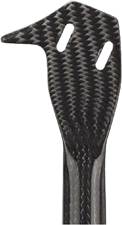
MEASURED PERFORMANCE
The 3150Hz test tone of a DIN 45-452 test disc measured 3186Hz on our Wow&Flutter meter, a speed error of + 1.1% which is high.
After a 24 hour run-in W&F measured a low 0.08%. Our Speed Stability spectrum analysis shows
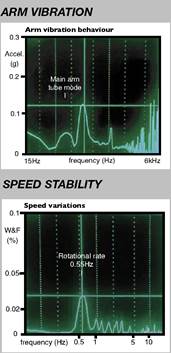
the main rotational variant at 0.55Hz (33rpm) is low and there was little flutter, making the Carbon RPM9 speed stable. Best results were with a very slack belt where the motor was not dominating the platter and the O-ring belt had little impact (inferior to flat ground belts, but cheaper). This allows platter mass to determine speed stability. Total Wow&Flutter (DIN weighted) measured 0.05%, a very good result. Measured to the Japanese JIS Standard the figure was 0.03%, JIS always giving a lower reading than German/European DIN. These figures are up with the best.
The arm had a first bending mode at 180Hz, our analysis of vibration, using a Bruel&Kjaer accelerometer on the head shell, shows. This is a classic tube resonance. There’s a second-order resonance at 350Hz too, both appearing as blips in the 2M Black’s frequency response trace.
The turntable measured well but the arm was mediocre by modern standards, due to obvious bending modes.
Speed error +1.1%
Wow 0.08%
Flutter 0.03%
Wow & Flutter (DIN wtd.) 0.05%
PRO-JECT RPM 9 CARBON DC
OUTSTANDING – amongst the best.
VERDICT
Henley Audio
+44 (0)1235 511166
www.henleyaudio.co.uk




